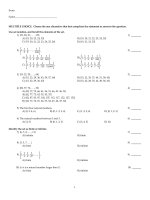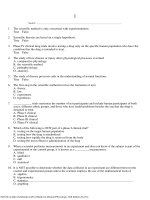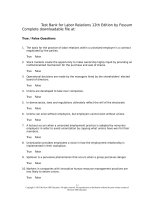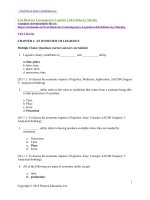Download test bank for economic development 12th edition by todaro
Bạn đang xem bản rút gọn của tài liệu. Xem và tải ngay bản đầy đủ của tài liệu tại đây (232.47 KB, 14 trang )
Test Bank for Economic Development 12th Edition by Todaro
Chapter 2
Comparative Economic Development
Key Concepts
In the new edition, Chapter 2 serves to further examine the extreme contrasts not only between
developed and developing countries, but also between different developing countries.
As in the last edition, Chapter 2 introduces quantitative comparison methods. After
classifying countries
as low–income, lower–middle income, upper–middle income, high-income OECD,
and other high-income countries (in accordance with the World Bank’s income
classification structure), Purchasing Power Parity (PPP) is explained as a tool to
make more accurate comparisons between countries based on income
level. As an alternative to the World Bank’s classification based on income, Chapter 2
looks at other key development factors such as education and gender inequality, mainly
through an introduction to the Human Development Index and how it is calculated. This
edition also introduces students to the new Human Development Index and how it differs
from the original HDI. It emphasizes the calculations of these two indexes and how a
nation’s income level is often not consistent with its HDI or NHDI. Numerous new
country comparison tables were added to better illustrate this point.
As in the 11th edition, the 12th emphasizes the similarities among developing
countries. The chapter stresses ten key similarities of developing countries:
Low levels of living and productivity
Low levels of human capital
High levels of income inequality and absolute poverty
©2015 Pearson Education, Inc.
Chapter 2 Comparative Economic Development
9
High rates of population growth
Social fraternization
Large rural population with rapid rural–urban migration
Low levels of industrialization
Adverse geography
Underdeveloped financial systems and markets
Lingering colonial impact and external dependence
Within the discussion of these similarities are highlights of the diversity among
developing nations despite their commonalities.
The chapter goes into greater detail when discussing that developing countries began
modern economic growth with initial conditions much different from those of the
developed countries. In comparison to the position of the developed countries on the
eve of their development, many of today’s LDCs have:
(the new edition specifically addresses the problems associated with remittances).
fewer growth benefits from international trade.
limited scientific and technological research capacity.
ineffective domestic institutions.
more limited natural resource endowments.
lower per capita incomes.
a less temperate climate and possibly unfavorable geographic conditions.
larger population sizes and growth rates.
fewer migration possibilities, but a larger “braindrain” problem among those who do migrate
This section is followed up by a discussion as to whether the living standards in
developing and developed nations are starting to converge.
A section on the long-run causes of comparative development provides a framework
linking these causes, designed purposely to give students a foundation for the following
chapters which discuss different theories of economic development. Included is a
diagram that is helpful for students when trying to visualize the linkages.
The chapter ends with a case study on Pakistan and Bangladesh.
Lecture Suggestions
As is stated in the in the text “… the characterization of the developing world as sub-Saharan
Africa, North Africa, the Middle East, Asia (except for Japan and, more recently South Korea and
perhaps two or three of the other high-income economies), Latin America and the Caribbean,
and the “transition” countries of eastern Europe and central Asia including the former Soviet
Union, remains a useful generalization” (page 42). This quote coupled with a brief discussion of
what is to be found in Table 2.1 (the fact that all low-income, low middle-income and upper
middle-income countries are to be found in the developing world as defined in the text) should
be sufficient. You can then turn to the question how the per capita income used in classifying
©2015 Pearson Education, Inc.
10
Todaro/Smith • Economic Development, Twelfth Edition
countries as developed and less developed is measured as well as the question of what
makes these economies more similar to one another than countries of the developed world.
Note that the text discusses GNI as opposed to GDP. Given that the vast majority of principles
of macroeconomics textbooks focus on GDP, it may be helpful to discuss the difference
between the two and the reason for using GNI rather than GDP to measure per capita income.
You should not go into any more detail than a particular class seems to need. You might also
like to consult Clara Capelli and Gianni Vaggi’s “A better indicator for the standard of living: The
Gross National Disposable Income” for a further refinement over GNI.
The GNI conversion problem. In order to classify countries according to GNI per capita each
country’s GNI must be converted to dollars. Asking a class if, given statistics on GNI for a
particular economy in local currency, how they would convert this figure into dollars you are
sure to be told that you should use the exchange rate. It is often useful at this point to ask
students if they have traveled and what the exchange rate has played as they paid for things
and tried to keep track of what they had spent. To being a discussion of the purchasing power
parity ratio, it is then helpful to again turn to the class, ask if they believe most things in lessdeveloped countries are as expensive as they are in developed countries. This invariably leads
to a discussion of why most items are significantly cheaper in the former. While the Big Mac
Index from the Economist helps illustrate this same point, another useful resource is the
website Numbeo .A quick calculation of the un-weighted average of the figures for groceries in
an LDC such as Bangladesh or simply the CPI +rent index given and then comparing these
results to the same data for the U.S., Japan, the U.K., or some other developed country
illustrates how the cost of living differed considerably across the world. To further drive the point
home it is often useful to compare the purchasing power parity ratios of different developed
countries. Particularly striking is a comparison of the U.S. and Japan. Finally, it is helpful to note
that the ratio of the purchasing power parity ratio to the exchange rate gives us a measure of
the relative cost of living and to discuss why this is the case. You could do a few calculations
showing the difference converting local currency figures into dollars using the purchasing power
parity ratio as opposed to the exchange rate. While going through these calculations (perhaps
having students do them themselves in class and provide you the answers) it is important to
emphasize that the purchasing power parity ratio’s sole function is to capture differences in the
cost of living and the exchange rate implies that the cost of living is equal across countries.
After discussing GNI and the GNI conversion problem you can also discuss:
Classifying countries using GNI per capita, or the human development index and
comparing the two classifications. Show the students what factors are represented in
the HDI and how it is computed
(note the new coefficients in the newer version). This can further focus student
attention on the broader meaning of development and the importance of looking
beyond average income levels. Table 2.4 on page 55 contrasts GDI per capita with
HDI levels to show that a certain level of GDI does not guarantee an equivalent HDI..
Characteristics such as education, literacy, and share of industry in GNI tend
to change predictably with the level of GNI.
©2015 Pearson Education, Inc.
Chapter 2 Comparative Economic Development
11
Section 2.4 goes into detail regarding the ten common features shared by developing
economies. Given that these are dealt with in detail in later chapters it might be best to simply
discuss most of these topics in very general terms at this point . For example, population growth
is the focus of Chapter 6 while education and formation of human capital is the focus of Chapter
8. Despite these similarities the differences need to be discussed as well. Perhaps the most
straightforward way to draw attention to the diversity that exists between developing nations is to
spend time discussing differences in natural resource endowments, weather, and climate as the
topic of adverse geography is discussed or the differences in the type of colonial regime as this
topic is discussed at the very end of section 2.4.
Introduce the concepts of modern economic growth and structural change. Traditional
society and modern economic growth can be placed in historical perspective and a short
discussion on the different conditions faced by developing countries and currently
developed countries can follow. The legacy of colonialism and dependence in
representative countries from various developing regions can be contrasted.
Discuss the various theories of Comparative Development.
Discussion Topics
Ask the students what they think the common features of developing countries are
and make a list of their suggestions on the board. At the end, add anything that they
have missed. Along the way you can elaborate on their suggestions.
Ask the students whether they think becoming more economically developed is
equivalent to becoming more industrialized. You can present data on the share of
industry in GDP, discuss the difference between necessary and sufficient conditions,
and introduce the concept of modern economic growth and the structural changes
that go along with development (this is discussed further in Chapter 3 as part of
the structural change theory).
Students will find it instructive to review the many differences between Europe on the eve of
its postwar “miracle” and developing countries at their time of independence. These
differences include infrastructure (at least engineering plans for destroyed sections), human
capital (such as industrial skills even if industry was destroyed), magnitude and type of
capital inflow, values of modernity, developing countries lower political autonomy and the
legacy of colonialism, and the fact European countries not only were not colonies
themselves but owned colonies. This topic can also be discussed in Chapter 3 as part of
the discussion of the Harrod-Domar model. The Harrod-Domar model worked well for the
European countries after WWII because they had the right complementary inputs in place.
Sample Questions
Short Answer
1. Explain how low levels of living can turn into a vicious cycle in developing
countries. Answer: See the section on low levels of living in the chapter.
©2015 Pearson Education, Inc.
12
Todaro/Smith • Economic Development, Twelfth Edition
2. Carefully explain some of the similar problems faced by otherwise diverse
countries in Africa, Asia, and Latin America.
Answer: This calls for students to summarize some of the main points
discussed in the chapter.
©2015 Pearson Education, Inc.
Chapter 2 Comparative Economic Development
13
3. What are some of the main ways in which the economies of developing countries
differ from one another?
Answer: See the Key Concepts above for a summary.
4. Explain why purchasing power parity measures of income levels tend to show a
smaller difference between poor and rich countries.
Answer: PPP measures show the number of units of developing country currency
required to purchase a basket of goods and services in the developing
country market that costs one dollar in the U.S. Prices for most services
tend to be much cheaper in developing countries than in the U.S.
5. In what way does nationalism tend to be a hindering force in attaining modern
economic growth and development, and in what way a facilitating force?
Answer: This is a question that would depend on what you have covered in lecture.
6. What are the three main indicators that make up the Human Development Index? Answer:
Life expectancy, educational attainment, GDP per capita measured in PPP terms.
7. If countries are first ranked by level of real GDP per capita, and then by the
value of the Human Development Index, would you expect the ranking of
countries to be similar or different? Explain.
Answer: The final column of Table 1 in the Human Development Report
(hdr.undp.org) shows the difference in ranking between the two
classification methods and students can be directed to that.
8. Comment on the following statement: The level and growth rate of real GDP per
capita can be a misleading indicator of development. At the same time, countries
that experience sustained increases in real GDP per capita over time will tend to
be more developed. Answer: Open-ended essay.
9. What are the three major components of economic growth?
Answer: Capital accumulation, labor force growth, and technological progress.
10. Explain the lingering effects of colonialism and how it is still playing a role in
hindering economic development in the developing world.
Answer: Answers should be based on the points covered in the section on
the colonial impact as well as in lecture.
11. Why might the use of more advanced technology not be a sufficient condition for
sustained economic growth?
Answer: It may require an inefficiently high capital labor ratio and complementary
factors, especially education, may be lacking. Additional points depend
on lecture coverage.
©2015 Pearson Education, Inc.
14
Todaro/Smith • Economic Development, Twelfth Edition
12. The 2006 Human Development Report reported that the HDI of South Africa was
0.653 (and its rank was 121) and that of the Peru was 0.767 (and its rank was 82).
South Africa’s per capita income
(in PPP dollars) was 11,192 and that of Peru was 5,678. Comment and explain.
Answer: Instructors can use figures similar to those in the question from the
most recent issue of the HDR updating this question. Students should
discuss the difference between economic growth (per capita income)
and economic development by discussing the components of the HDI.
13. What are remittances and what role do they in developing countries? How
could this potentially benefit an economy?
Answer: An answer should pose a definition, mention how remittances reduce
poverty for many migrants and their families, and speak to the possible
net increase in labor force skills driven by the desire to emigrate.
14. Are living standards in developed and developing countries converging? Give
evidence to support your answer.
Answer: Answers should refer to Figures 2.7–2.9 and the supporting text.
How do differences in culture lead to comparative development?
Answer: Cultural factors effect the development and amount of emphasis put on
education, institutions, and how effective civil society is. An important part
of the answer should be how the role of culture has not been clearly
established due to its complexity.
15. In what way(s) do the development paths chosen by Pakistan and Bangladesh
differ? What are the main factors that have contributed to these differing paths?
Answer: The key differences are the aspects of economic development discussed in the
chapter. The case study at the end of the chapter provides comparative figures
for the two countries and the main factors contributing to the divergent paths.
16. How is poverty measured? What is the extent of poverty in the developing world?
Answer: The concept of absolute poverty is discussed in the text and the
progression of absolute poverty in the developing world is shown in
Figure 2.6. If the concept of relative poverty was discussed in the
lectures, instructors may look for that distinction in the answer.
17. What are the major differences between the new HDI and the original HDI?
Answer: Open ended essay. Refer to pages 51–55 of text for the discussion.
Multiple Choice
1. An example of an upper-middle income
country is a. India.
©2015 Pearson Education, Inc.
Chapter 2 Comparative Economic Development
b. Brazil.
c. Indonesia.
d. Nigeria.
Answer: B
©2015 Pearson Education, Inc.
15
16
Todaro/Smith • Economic Development, Twelfth Edition
2. A newly industrialized country is
a. the same as a high-income country.
b. any country that has experienced sustained growth in industry.
c. a special classification given to some upper-middle income countries
that have achieved relatively advanced manufacturing sectors.
d. any country that has moved out of lower income status.
Answer: C
3. Which of the following is not an upper-middle income country?
a. Brazil
b. South Africa
c. Pakistan
d. Argentina
Answer: C
4. Which of the following is a low-income country?
a. Mexico
b. Thailand
c. Turkey
d. Bangladesh
Answer: D
5. One of the components of the human development index is
a. the percentage of the population who are high school graduates.
b. the average daily intake of protein.
c. life expectancy at birth.
d. the number of doctors per hundred people in the population.
Answer: C
6. What percent of the world’s nations have at least five significant ethnic populations?
a. 0–10
b. 10–20
c. 20–30
d. 30–40
e. over 40
Answer: E
7. What fraction of developing countries have recently experienced some form of
significant interethnic conflict?
a. less than one-tenth
b. a tenth to one-quarter
©2015 Pearson Education, Inc.
Chapter 2 Comparative Economic Development
c. one quarter to one half
d. over one
half Answer: D
8.
Which of the following African countries has experienced widespread death and
destruction due to ethnic or clan based conflict in the previous decade?
a. Rwanda
b. Sudan
c. Somalia
d. all of the above
Answer: D
9. Which measure uses a common set of international prices for all goods and
services produced?
a. purchasing power parity income levels
b. GNI price deflators
c. foreign exchange rate conversions to U.S. dollars
d. the exchange rate
Answer: A
10. The number of units of developing country currency required to purchase a basket of
goods and services in a developing country that costs one dollar in the U.S. is given by
a. GNI price deflator.
b. Human Development Index ranking.
c. purchasing power parity.
d. the exchange rate.
Answer: C
11. About how many people lack access to basic sanitation?
a. 20 million
b. 200 million
c. 500 million
d. 1 billion
e. 2 billion
Answer: E
12. About how many people lack access to safe water?
a. 20 million
b. 200 million
c. 500 million
d. 1 billion
e. 2 billion
Answer: D
13. About how many malnourished children under age five are there in the developing world?
©2015 Pearson Education, Inc.
17
18
Todaro/Smith • Economic Development, Twelfth Edition
a. 20 million
b. 150 million
c. 500 million
d. 1 billion
e. 2 billion
Answer: B
©2015 Pearson Education, Inc.
Chapter 2 Comparative Economic Development
14. Neutral technological progress occurs when
a. higher output levels are achieved with the same quantity and combinations
of factor inputs.
©2015 Pearson Education, Inc.
19
20
Todaro/Smith • Economic Development, Twelfth Edition
b. higher output levels are achieved by more capital intensive methods.
d. higher output levels are achieved by more labor intensive methods.
e. higher output levels are achieved.
Answer: A
15. Conditions of today’s developed countries at the start of their industrialization
differ from conditions in the developing world in that
a. population growth rates were higher.
b. more advanced technology was available.
c. there were more opportunities for development assistance.
d. none of the above.
Answer: D
16. Most successful examples of modern economic growth have occurred in a country with
a.
b.
c.
d.
a temperate-zone climate.
a market economy.
exports of manufactured goods.
all of the above.
Answer: D
17. Which of the following is not an indicator that is used by the World Bank in
measuring the level
of economic development?
a. life expectancy at birth.
b. adult literacy rate.
c. infant mortality rate.
d. all of the above are not used by the World Bank.
Answer: D
18. The dependency burden is
a. a measure of the degree to which the less developed countries are dependent
on the rich industrial countries.
b. the average number of children that a woman gives birth to during her lifetime.
c. the number of babies born per 1000 persons.
d. the percent of the population that is below 15 and above 65 years of age.
Answer: D
19. How many people still live on less than the equivalent of $1.25 per day (new definition of
“extreme poverty”)?
a. 100 million.
b. 500 million.
©2015 Pearson Education, Inc.
Chapter 2 Comparative Economic Development
c. 1.4 billion.
d. 2.2 billion.
Answer: C
20. Which of the following is not an indicator that is used to compute the Human
Development Index?
a. life expectancy at birth.
b. real GDP per capita.
c. infant mortality rate.
d. adult literacy rate.
Answer: C
21. The combined GDP of developing countries constitutes approximately
a. 5 percent of global GDP.
b. 20 percent of global GDP.
c. 30 percent of global GDP.
d. 40 percent of global GDP.
Answer: D
22. Developing countries are starting to converge with developed countries in the
long run in what respect?
a. Growth rate
b. Income inequality
c. Population
d. Per capita income
Answer: D
23. Which region in the world has the lowest GNI per capita based on the World
Bank Atlas method?
a. Sub-Saharan Africa
b. East Asia/Pacific
c. South Asia
d. Latin America/The Caribbean
Answer: C
©2015 Pearson Education, Inc.
21









